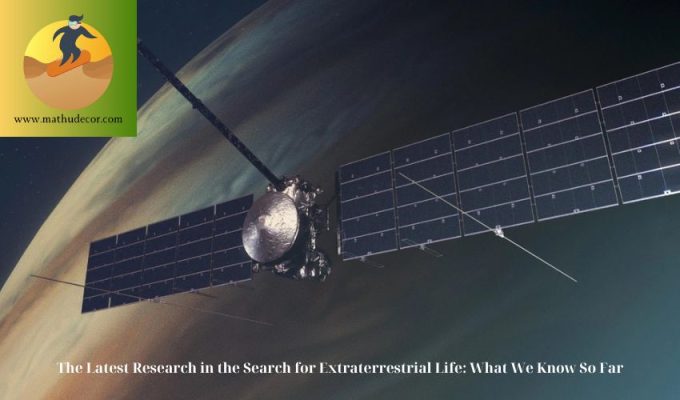
Discover the latest developments in the search for extraterrestrial life and what researchers have uncovered so far.
Scientific Methods for Searching for Extraterrestrial Life
The search for extraterrestrial life involves a variety of scientific methods, including the use of telescopes and spacecraft to study exoplanets and their atmospheres. One method, known as transit spectroscopy, involves analyzing the light from the atmospheres of exoplanets to identify the presence of gases and chemicals that could be linked to life. This method could provide valuable information about the potential habitability of distant worlds.
Transit Spectroscopy
Transit spectroscopy is a technique used to study the atmospheres of exoplanets as they pass in front of their host stars. By analyzing the light that passes through the exoplanet’s atmosphere, scientists can identify the presence of specific gases and chemicals that may indicate the presence of life. This method has the potential to provide crucial insights into the conditions on distant worlds and the likelihood of finding extraterrestrial life.
– Analysis of exoplanet atmospheres
– Identification of gases and chemicals linked to life
– Insights into potential habitability of distant worlds
Overall, the scientific methods for searching for extraterrestrial life involve a combination of advanced technology, careful observation, and analysis of data from distant planets and their atmospheres. These methods are crucial for advancing our understanding of the possibility of life beyond Earth and could ultimately lead to groundbreaking discoveries in the field of astrobiology.
Promising Discoveries and Breakthroughs
NASA has made significant progress in the search for extraterrestrial life, with promising discoveries and breakthroughs that have brought us closer to answering the age-old question of whether we are alone in the universe. From the detection of potentially habitable exoplanets to the development of advanced telescopes and spacecraft, the search for life beyond Earth has reached new heights. Scientists are constantly pushing the boundaries of our understanding of the cosmos, and their efforts have yielded exciting results that could change our perspective on the existence of life in the universe.
Breakthroughs in Exoplanet Research
In recent years, astronomers have made groundbreaking discoveries in the field of exoplanet research. The identification of Earth-sized exoplanets within the habitable zone of their host stars has raised hopes of finding environments that could support life as we know it. The James Webb Space Telescope, launched in 2021, is poised to revolutionize our ability to study exoplanet atmospheres and detect the telltale signs of life. With the potential to analyze the chemical composition of distant worlds, this cutting-edge instrument represents a major breakthrough in our quest to find habitable exoplanets and potential extraterrestrial life.
– Detection of Earth-sized exoplanets within the habitable zone
– Launch of the James Webb Space Telescope for advanced exoplanet research
Advancements in Astrobiology
NASA’s Astrobiology Program has played a crucial role in driving forward the search for life beyond Earth. Through a combination of space missions, laboratory experiments, and theoretical modeling, scientists are gaining a deeper understanding of the conditions that could support life in our solar system and beyond. From the exploration of Mars and the search for subsurface oceans on icy moons to the study of extremophiles on Earth, astrobiologists are uncovering new insights that could guide the search for extraterrestrial life. These advancements in astrobiology are laying the groundwork for future missions and discoveries that could reshape our understanding of life in the universe.
– Exploration of Mars and search for subsurface oceans on icy moons
– Study of extremophiles on Earth to understand potential analogs for extraterrestrial life
The Future of Extraterrestrial Life Research
As technology continues to advance, the future of extraterrestrial life research looks promising. With the launch of the James Webb Space Telescope in 2021, scientists are hopeful that they will be able to detect signs of life in the atmospheres of exoplanets. This telescope, along with future spacecraft, could provide valuable insights into the possibility of life beyond Earth. Additionally, advancements in transit spectroscopy, a method that allows scientists to analyze the chemical composition of exoplanet atmospheres, will play a crucial role in the search for extraterrestrial life.
Advancements in Technology
The development of more advanced telescopes and spacecraft, such as the James Webb Space Telescope, will greatly enhance our ability to detect signs of life in the universe. These technological advancements will allow scientists to gather more detailed and accurate data from distant exoplanets, bringing us closer to answering the age-old question of whether we are alone in the universe.
– Improved telescopes and spacecraft
– Enhanced data collection and analysis capabilities
– Greater precision in detecting signs of life
Exploration of Extreme Environments
In addition to technological advancements, the future of extraterrestrial life research will involve further exploration of extreme environments on Earth. By studying extremophiles – organisms that thrive in harsh conditions – scientists hope to gain insights into the types of environments that could potentially support life on other planets. This research will help identify potential analogs for extraterrestrial life and inform the search for habitable worlds beyond our solar system.
– Study of extremophiles and their adaptation to extreme environments
– Identification of potential analogs for extraterrestrial life
– Insights into the conditions that could support life on other planets
By leveraging these advancements in technology and exploring extreme environments on Earth, the future of extraterrestrial life research holds great promise for unlocking the mysteries of the universe.
In conclusion, ongoing research in the field of astrobiology and space exploration is focused on identifying potential habitable environments on other planets and moons, detecting biosignatures, and developing advanced technology to search for extraterrestrial life. These efforts are driven by the curiosity to understand our place in the universe and the possibility of finding life beyond Earth.



Leave a Reply